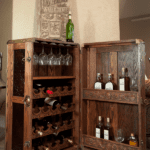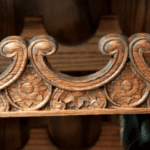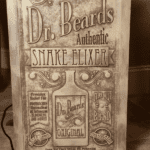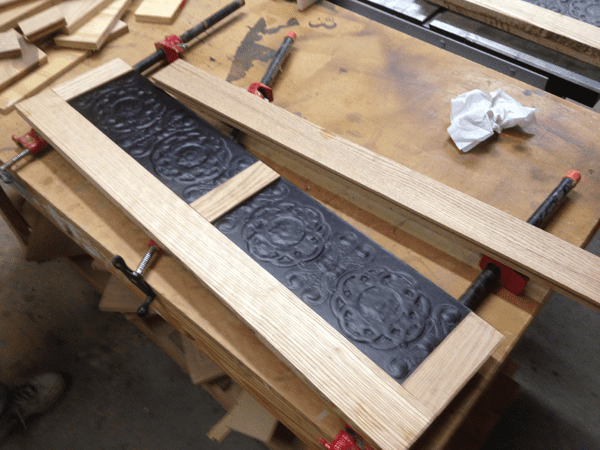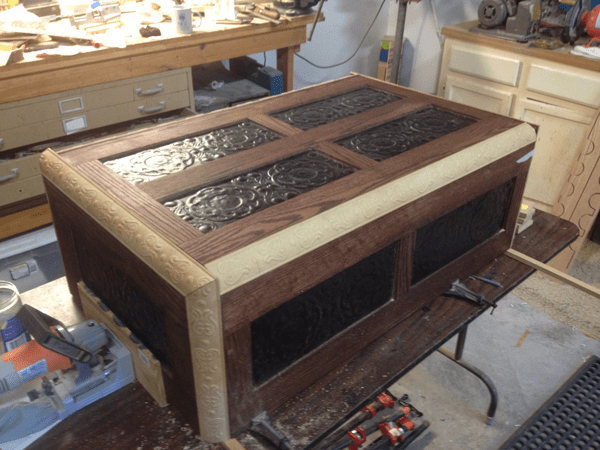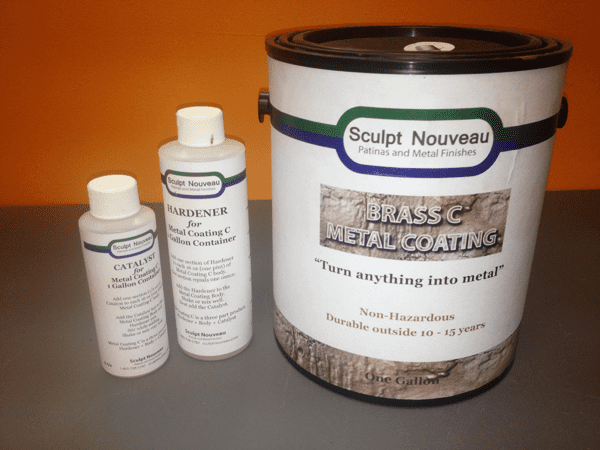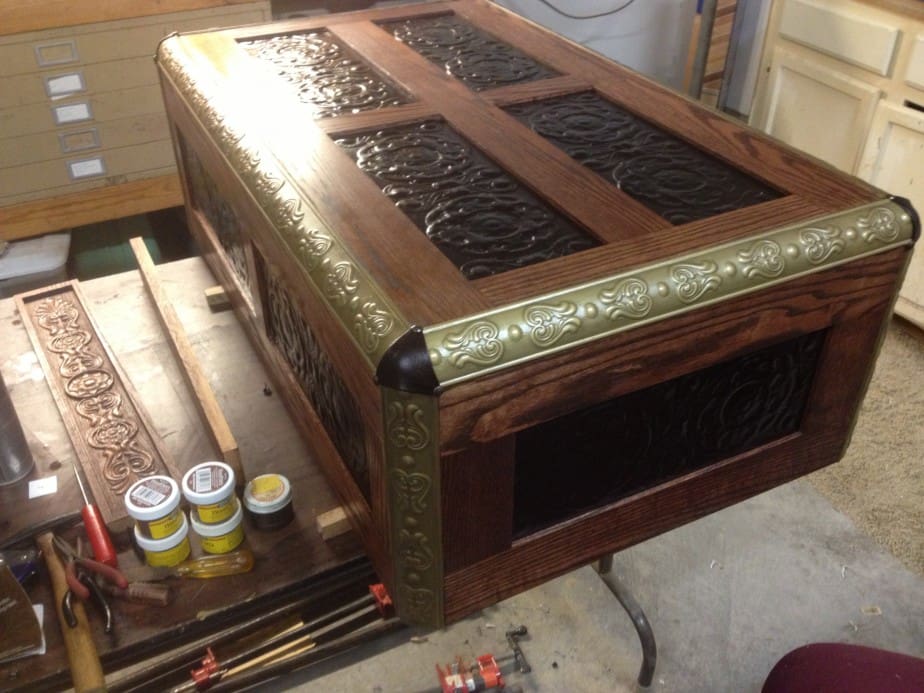Dr. Beards Apothecary Trunk Project
For the 2013 CarveWright Conference I wanted to build something big. I wanted a project that inspired and spoke to a variety of people and their diverse interests. I wanted to do a piece of cabinetry, but also wanted to use some experimental techniques to show off some new possibilities. We had created a “New Industrial Revolution” theme for the conference, so I wanted to keep things in a 1900 era theme. So, with much research and contemplation, I came up with a steamer trunk wine cabinet. The result is the Dr. Beards Apothecary trunk, complete with carved Dr. Beards Snake Elixir poster.
Below is a gallery of the finished trunk and 3 videos outlining much of the process of creating and building this trunk. The video’s are rather lengthy, sorry about that, but they were captured from my presentation about the trunk at the 2013 CarveWright Conference, so they have a ton of information in them. It was a big job, but a fun build and hopefully inspires some of you to try that bigger project you’ve been contemplating.
CarveWright Trunk Project Part 1: Freehand Modeling
CarveWright Trunk Project Part 2: Basic and Tracing Image Modeling
CarveWright Trunk Project Part 3: Project Design and Creation Techniques
Assembly and Construction
I built this project with red oak mainly because it is the only hardwood readily available down here in the Houston area. Plus, I was at HomeDepot one day and found a special on 4′ 1×8 red oak boards for $8.88 each. I grabbed a cart and loaded it with every straight board they had in that display, and then I went to the next nearest HomeDepot and did the same. I ended up with a all the solid wood I would need for my project for about $100. Not a bad start. All I needed now was some 1/4″ red oak plywood, some leather for the panels, and the trunk hardware. After going to every HomeDepot, Lowes’s, and other lumber sources within 30 miles of me, I finally found enough of the oak plywood to do the backs of my panels. That stuff was elusive, and I was beginning to think Id never find it. Then next off to the fabric store. In my experiments with stamping tin, I had priced leather and knew it was going to be far too expensive for the amount that I was needing, but I had experimented with some interesting fake leather vinyls that looked like I could use. Digging through the remnant rack, I found what I had been hoping for. One of the high end vinyl “leathers” in the perfect color and more than enough to do the job, and the entire remnant was less than one yard of the stuff on the display. Score again, so far I’m doing really well with the budget on this thing. I had already searched online and found all the hardware I needed, so I got it ordered, and got started on the build.
I stated with the panels, making my dies and perfecting my process for stamping and mounting the panels. See the Part 3 video above to see that process.
Then I needed to dado the stiles and rails after they had been cut to size in order to slide the panels into them. Then I used biscuit joints to glue the entire assemblies together. The smaller pieces went pretty easy, but the bigger panels where tricky to keep together.
After the panels where assembled they were sanded carefully and thoroughly. I used a Ryobi mouse sander for most of it and finished by hand with 220 on sanding blocks. Then the pieces where stained with Minwax deep penetrating “Red Mohogany stain and set aside to dry.
The corner trim pieces for this project were key to the whole trunks assembly. These panels were to be joined to make 2 open ended boxes. One for the body of the trunk and one for the lid. I started by laying out the design for the corner trim. I had the precise dimensions already worked out in the detailed plans I drew before beginning this project, so I created a long extrusion based on those dimensions. Then I applied my patterns to it and carefully spaced them with the copy offset too. I did a 3″ spacing s0 I could get even spacing on all sides of the trunk. My panel dimensions where all based on 3″ increments. The large panel is 36″x21″ for example. I needed a lot of this trim material, so I carved 3 at a time twice.
I chose to do it MDF because these will be painted so I don’t want to deal with having to cover any grain with several primer coats and a ton of sanding. I’ve found a technique with MDF that works really well for quickly cleaning it up. First I seal it, front and back, with several coats of spray shellac. This process seems to harden and kind of crystallize the “fuzzies” on the carving so they just break off when you go to your sanding mop. Rather than spray primer which usually turns those fuzzies into a sponge which makes even more difficult to sand away. This technique works great for pine and other soft woods as well. Once these were sanded and smooth, I then needed to glue them to the corner blocks. The corner blocks were made by gluing together two 3/4″ think oak boards to make a 1 1/5″ board, then ripping them at a 45° on a table saw to make the corner blocks. Then I glued the rounded trim piece to them and the result was a custom carved quarter round.
Now with the panels made and to corner trim pieces created, its time to assemble these boxes. This was done with biscuits, glue and some brad nails to assist in keeping it together since clamping this structure was starting to get really tricky. I mitered the end pieces like three sided picture frames, but left the longer lengths with flat ends to butt underneath the ends. This created an overhang that I needed to sand down to make round.
The corners were ground down and we filled and sanded everything. Once smoothed and filled, it was time for masking so we could paint the trim pieces.
I have been experimenting with several finishing techniques and along the process, I started playing with Sculpt Nouveau’s products. Sculpt Nouveau makes spectacular metallic finishes and patinas available. Several CarveWright customers, such as Michael Tyler and Doug Haffner swear by these paints, and now so do I. If you want something to look like metal even though its not, these are the products to look into. http://www.sculptnouveau.com/ For his project I was planning to use antiqued brass hardware, so I went with the Brass C coating and mixed up my paint.
Application of this paint was pretty easy. They recommend to spray it, and I was prepared to do so, but in my test pieces, I just used a foam brush and the results came out good, so to reduce the amount of masking I simply brushed the paint on with foam brushes. I did about 4-5 coats to get it nice and thick. The neat thing about this paint, is that is has so much real metal in the paint, it can actually be polished! Once the paint was dry, I polished it with 0000 steel wool until the raised areas were nice and shiny. Then I went over it all with black shoe polish to “antique” it, trying to match the hardware as best I could.
Next I clear coated the inside and outside of all the pieces with spray polyurethane, and waited a day for it to dry.
The inside assembly was fairly simple. I mounted supports for the rack pieces which were tall enough to form the shelf support. The shelves on the lid side where screwed into supports placed underneath them. All the pieces were measured and cut to fit, stained, and then clear coated before being installed.
Now, I had to figure out what to do with the corner pieces. I had the leftover leather material from making the panels, so I was sure I wanted to use that, but figuring out how to wrap those corners with it was not obvious. After several tries with many different shapes, I finally found one that worked pretty well.
The trick ended up being to use spray adhesive on the back of the shape above, and then fold in the lighter areas underneath to create a triangle with nice finished edges. Then I tacked down one corner with brass tacks I picked up at hobby lobby in their upholstery section. Once that first tack as in place, I used that pair of needle nose pliers to grab the next corner and stretch it across and tack it. Then stretch the last corner in place. The stretching made the corners wrap much better and the spray adhesive seemed to make the material hold the stretched shape much better. With the tacks were in, you can trim the excess leather to clean up any overhangs. The results were a very nice accent to the piece.
The last thing to do was the hardware, which was pretty standard installation. Pilot holes and a few screws later, I was done.
I hope you enjoyed this project. It was a big undertaking, but very well worth it. This piece will be displayed with pride for years to come. I don’t get tired of saying “I made that”.
To see more how I made the Dr. Beards Poster project, you can download the pdf tutorial on the Designer 2 tutorials page here. Just scroll to the bottom. It is a demonstration of the new text tools in the Designer 2 Upgrade software. Very cool stuff.
Also, the project files for this trunk are available for free along with the other conference materials here. The files will only open in Designer 2. The patterns are available individually in the Pattern Depot bu searching for “trunk” or by purchasing the 2013 Conference Collection here.
Explore Project Categories
Customer Stories
News
Subscribe To Our Newsletters
Learning, projects, customer highlights, and promotions in your inbox!




